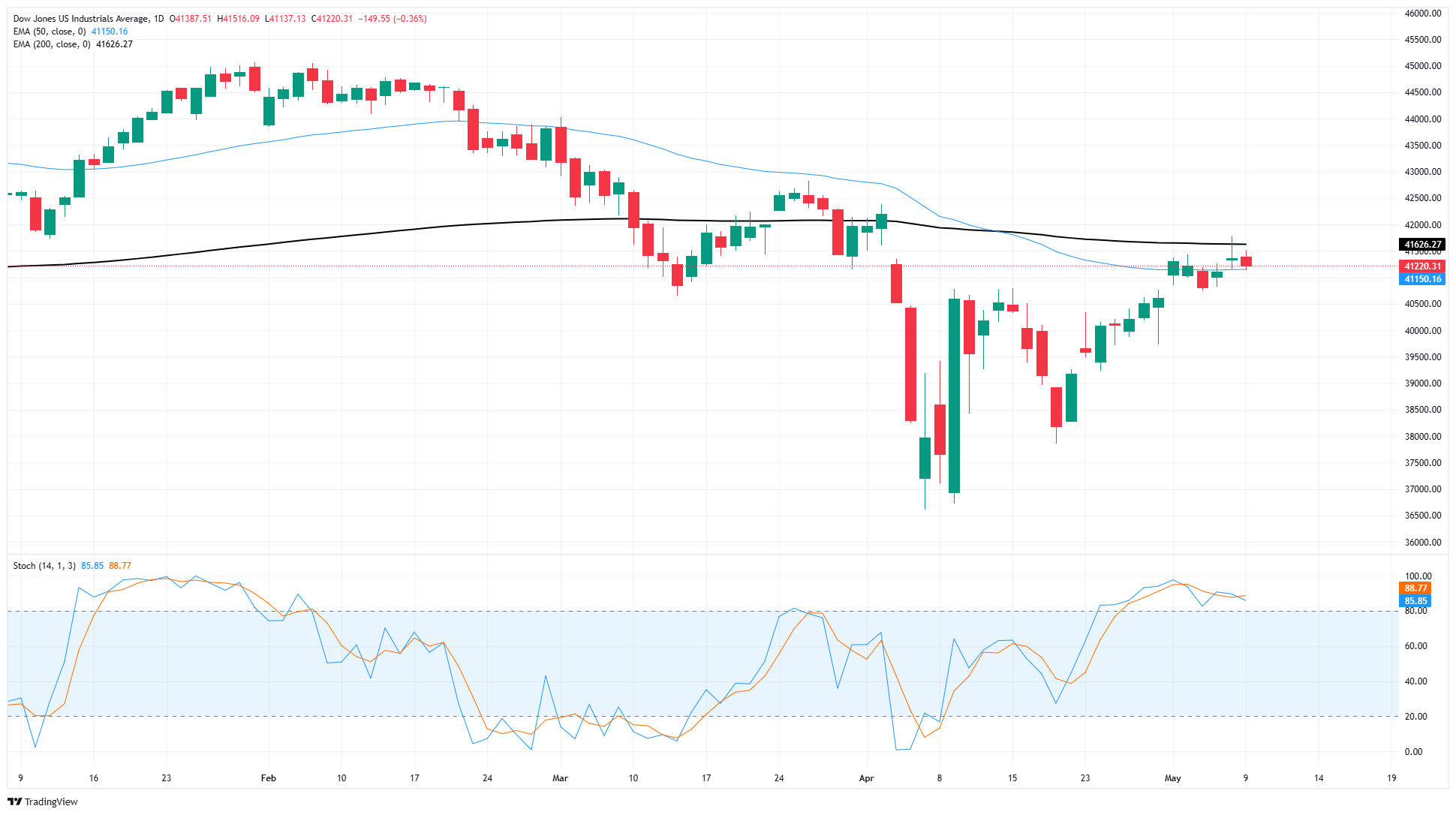Created
: 2025.05.10














![]() 2025.05.10 02:32
2025.05.10 02:32
The Dow Jones Industrial Average (DJIA) followed the broader market lower on Friday, declining to 41,150 as investors gear up for a tense weekend. The United States (US) and China are headed for opening trade talks in Switzerland this weekend, but policymakers from both administrations have cautioned that talks will be strictly preliminary. Chinese delegates have specifically warned that a definitive deal could be months away.
US President Donald Trump hit social media early on Friday, publicly musing about a potential walkback of tariffs on Chinese goods that currently stand at an eye-watering 145%. Donald Trump floated the idea of reducing Chinese tariffs to 80%. An 80% tariff on Chinese goods is indistinguishable from 145%, as both levels are so high that they functionally represent an embargo on cheap trade, which the entire US economy is wholly dependent on.
The Federal Reserve (Fed) hit a firm wait-and-see tone this week, after holding interest rates steady in May. A slew of Fed policymakers made public appearances on Friday, but they all put significant effort into avoiding speaking directly on monetary policy. The Fed looks set to continue shrugging its shoulders at the uncertainty from lopsided trade policy rendering it impossible to accurately forecast economic outcomes, leaving the data-dependent Fed planted firmly on the sidelines.
According to the CME's FedWatch Tool, rate traders are still pricing in better-than-even odds of the Fed being forced to deliver another quarter-point rate cut in July, but bets have been bleeding back toward another rate hold. At the current cut, rate markets are pricing in a 40% chance that the Fed won't cut in July either, up from the 20% to 30% odds were floating around earlier this week.
The Dow Jones is poised for an extended backslide after flubbing a bullish run at the 200-day Exponential Moving Average (EMA) near 41,600 this week. Price action is easing back down from the key moving average, but near-term technical support is getting priced in at the 50-day EMA near 41,150.
Despite dark technical clouds gathering overhead, momentum still rests firmly in the hands of bidders. The Dow Jones has recovered over 12.5% from April's plunge below 37,000, and bids have continued to grind higher as market sentiment recovers.

The Dow Jones Industrial Average, one of the oldest stock market indices in the world, is compiled of the 30 most traded stocks in the US. The index is price-weighted rather than weighted by capitalization. It is calculated by summing the prices of the constituent stocks and dividing them by a factor, currently 0.152. The index was founded by Charles Dow, who also founded the Wall Street Journal. In later years it has been criticized for not being broadly representative enough because it only tracks 30 conglomerates, unlike broader indices such as the S&P 500.
Many different factors drive the Dow Jones Industrial Average (DJIA). The aggregate performance of the component companies revealed in quarterly company earnings reports is the main one. US and global macroeconomic data also contributes as it impacts on investor sentiment. The level of interest rates, set by the Federal Reserve (Fed), also influences the DJIA as it affects the cost of credit, on which many corporations are heavily reliant. Therefore, inflation can be a major driver as well as other metrics which impact the Fed decisions.
Dow Theory is a method for identifying the primary trend of the stock market developed by Charles Dow. A key step is to compare the direction of the Dow Jones Industrial Average (DJIA) and the Dow Jones Transportation Average (DJTA) and only follow trends where both are moving in the same direction. Volume is a confirmatory criteria. The theory uses elements of peak and trough analysis. Dow's theory posits three trend phases: accumulation, when smart money starts buying or selling; public participation, when the wider public joins in; and distribution, when the smart money exits.
There are a number of ways to trade the DJIA. One is to use ETFs which allow investors to trade the DJIA as a single security, rather than having to buy shares in all 30 constituent companies. A leading example is the SPDR Dow Jones Industrial Average ETF (DIA). DJIA futures contracts enable traders to speculate on the future value of the index and Options provide the right, but not the obligation, to buy or sell the index at a predetermined price in the future. Mutual funds enable investors to buy a share of a diversified portfolio of DJIA stocks thus providing exposure to the overall index.
![]()
Created
: 2025.05.10
![]()
Last updated
: 2025.05.10

FXStreet is a forex information website, delivering market analysis and news articles 24/7.
It features a number of articles contributed by well-known analysts, in addition to the ones by its editorial team.
Founded in 2000 by Francesc Riverola, a Spanish economist, it has grown to become a world-renowned information website.
We hope you find this article useful. Any comments or suggestions will be greatly appreciated.
We are also looking for writers with extensive experience in forex and crypto to join us.
please contact us at [email protected].
Disclaimer:
All information and content provided on this website is provided for informational purposes only and is not intended to solicit any investment. Although all efforts are made in order to ensure that the information is correct, no guarantee is provided for the accuracy of any content on this website. Any decision made shall be the responsibility of the investor and Myforex does not take any responsibility whatsoever regarding the use of any information provided herein.
The content provided on this website belongs to Myforex and, where stated, the relevant licensors. All rights are reserved by Myforex and the relevant licensors, and no content of this website, whether in full or in part, shall be copied or displayed elsewhere without the explicit written permission of the relevant copyright holder. If you wish to use any part of the content provided on this website, please ensure that you contact Myforex.
Myforex uses cookies to improve the convenience and functionality of this website. This website may include cookies not only by us but also by third parties (advertisers, log analysts, etc.) for the purpose of tracking the activities of users. Cookie policy